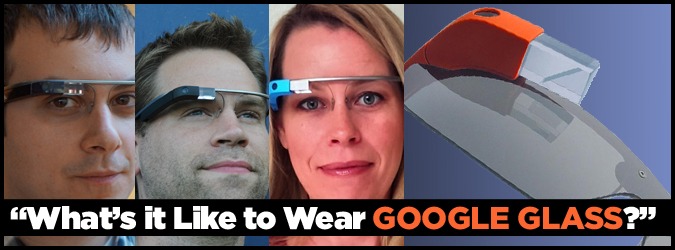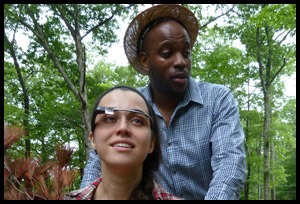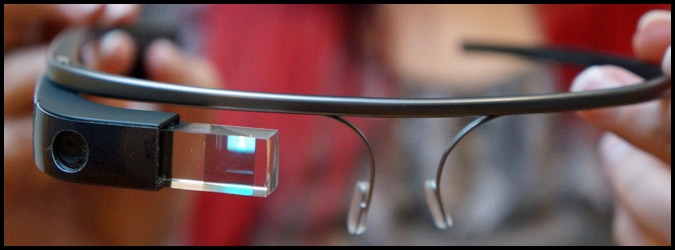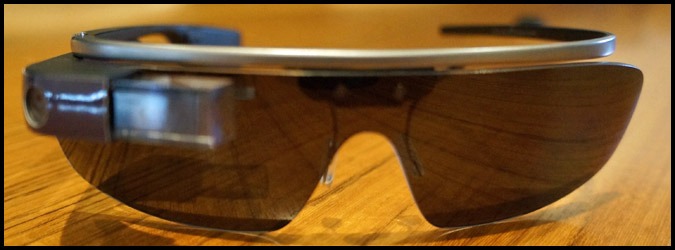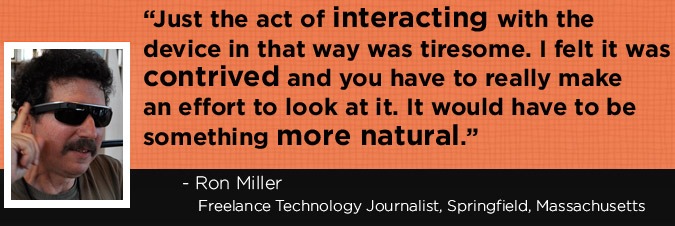Google Glass: What Explorers Love and Hate
What if you never had to dig out your phone to snap a photo or squeeze it out of your pocket to answer a phone call? Imagine a world where you wouldn’t have to gaze down at your handset to send a text as you walk down the street. This is the type of experience that Google seeks to create with its Glass headset-- a world that puts technology in your line of vision rather than in the palm of your hand.
Google’s promotional videos depict Glass as a revolutionary product that can change the way we interact with the world, but is that what it’s really like to wear Glass? The $1,500 Explorer Edition has been available for developers for months, but the Glass experience is still largely a mystery for most.
Here’s what six Google Glass wearers had to say about their time with Google’s heads-up display so far.
A Second Set of Eyes
With Glass, Google seeks to stick the smartphone experience right in front of your eyes, lessening the need to actually whip out your device. But according to those who have been using Glass for months, the wearable gadget is most useful as a wearable camera.
MORE: Nokia Lumia 1020 vs. Galaxy S4 Zoom: The Best Camera Phone Is...
“I think the value is there in the sense that it really does save time,” said Liza Gere, an IT professional based in Calif. currently working on a startup that focuses on making apps for Glass. “There were so many moments I would have missed if I had to spend those extra few minutes getting my phone.
Not only does Glass minimize the time it takes to start snapping photos, it allows opportunities that wouldn’t be possible otherwise. In 2011, Columbia law school student Alexandra Blaszczuk suffered a severe spinal cord injury during a car accident on a road trip to Vermont.
Sign up to receive The Snapshot, a free special dispatch from Laptop Mag, in your inbox.
Since then, Blaszczuk has been paralyzed from the chest down, meaning that she needs assistance to accomplish most daily tasks. But Glass allows her to interact with others in a way that she hadn’t been able to since her injury.
“Glass has really changed the game for me in terms of what I can do,” she said. “There isn’t really anything else on the market that would allow me to do that.”
Blaszczuk says she often uses Glass for photography during her travels, which provides an outlet for her to be an active member of the group despite her physical limitations.
“Usually when we go camping, everybody has a role like setting up the tent, gathering wood, or something else that’s physically active,” she said. “Since I can’t do that, Google Glass has helped me find other roles like being the photographer or the navigator. And it was really cool to have that responsibility, especially in the context of finding functionality for people with disabilities in the social space.”
MORE: Top 10 Features of Google Glass
A New Way to Teach
For others, Glass has redefined roles in the professional world. Andrew Vanden Heuvel is a science teacher at Michigan Virtual University who was selected as Michigan Teacher of the Year in 2010. He uses Glass to create first-person videos and live broadcasts for his students.
“What’s interesting is that Google Glass has expanded what I consider to be my students,” Heuvel said. “I feel like I’m able to reach a wider audience with these high engagement videos.”
Vanden Heuvel has uploaded more than 100 educational science videos to his YouTube account and has been wearing Glass for about six months. In addition to using the headset for filming videos, Vanden Heuvel says Glass is ideal for broadcasting lessons via Google Hangouts. He once dictated a lesson to three different classes at once directly from his kitchen.
“I’m super excited for the potential Google Glass has for that kind of stuff, like asking questions in real time,” Heuvel said. “I really want to do more of that.”
How It Feels
In order for Google Glass to be embraced by the masses, the design needs to be attractive and unobtrusive. Although the idea of wearing a miniature display on your face may sound awkward, the wearers we interviewed say that Glass feels completely natural.
“It is very much not there until wanted,” said Donald Schwartz, a Web developer currently creating Glass apps for architectural design and construction. “I forget I’m even wearing them until it beeps with a notification.”
MORE: Don’t Be A Glasshole: 10 Etiquette Tips
“I literally never take my Glass off,” Gere said. “I’m probably one of the few people that pretty much uses it for everything. I don’t usually wear glasses so I’m not used to having something on my face, but Google did an amazing job of keeping it lightweight.”
Ron Miller, a freelance technology journalist and editor at FreeContentManagement, returned his Glass within 30 days of purchasing the Explorer edition. But this decision had nothing to do with the headset’s aesthetics.
“It was incredibly lightweight, and actually pretty cool from that perspective,” Miller said. “For a person wearing glasses it was more difficult, but in terms of adding weight to my glasses it wasn’t an issue.”
But for those who wear their Glass all day such as Gere, its presence becomes more pronounced. Gere says that the area on the top of her ear where Glass rests can become irritated after long periods of time, so she suggested that Google add a gel tab or something similarly soft for extra comfort.
Public Reactions
While Google Glass has a cyborg vibe to it, the design is actually more discrete than you may think. Some Explorers said the headset attracted little to no public attention.
“The big surprise is most people didn’t even notice or care,” Vanden Heuvel said. “Of the people I speak to directly, only about 50 percent of them ask what’s on my face. It’s bizarre.”
Miller had a similar experience when wearing Glass in public, but for other wearers the situation was slightly more complicated, especially for Blaszczuk.
“I’ve gotten the full spectrum of reactions,” she said. “I think there are some people that are kind of careful in approaching me because they’re not sure if its Google Glass or something else that I need for my disabilities and whether they can ask about it.”
That doesn’t mean onlookers aren’t curious about the device. According to Gere, the intrigued glances aren’t always noticeable in the moment, but become visible when looking at photos taken with Glass.
“If you’re in a crowded environment, there are a lot more looks than you can even perceive,” she said. “You begin to realize how many people are looking at you and identifying that you have Glass.”
For others such as Schwartz, the reaction from others has mostly been excitement, especially when wearing his Glass to networking events. “Most people are thrilled,” he said. “Young people scream when they see it. You feel like a dork at first but then you become used to meeting people nonstop.”
However, there is a way to wear glass more discretely for those looking to stay out of the spotlight.
“If you wear the sunglass lens accessory, people tend to notice less,” said Raffi Asdourian, video editor for Investigation Discovery’s “On the Case With Paula Zahn” and independent photographer/filmmaker. “Because so few people actually have them, when you wear them in public you naturally get a lot of stares.”
MORE: Google Glass Alternatives
Privacy Concerns
As innovative as Glass may be for some, it’s difficult to ignore the raging privacy controversy. The idea of people roaming the streets with a wearable camera on their face was enough for a Seattle bar to ban its patrons from wearing the headset. Activists groups such as Stop The Cyborgs encourage establishments to place bans on Google Glass usage. The group’s website features anti-Google Glass signs that viewers can download and print out to post as a signifier that Google Glass isn’t welcome.
According to a University of London study, one in five people people Google Glass should be banned. Privacy was the main reason cited. Nearly two-thirds said Glass and other types of wearable devices should be regulated.
At the same time, lawmakers are concerned by the privacy implications raised by Glass. Congress has been prodding Google for more information about how Google uses information obtained by Glass, but the company has downplayed any potential risks.
“It kind of seems like a publicity stunt,” Miller said in reference to The 5 Point’s ban on Glass. “Did they ban smartphones? No. Are people not taking pictures and videos in that bar?”
Miller also acknowledges that recording video with Glass isn’t as conspicuous as it may seem. Deliberate actions are required to trigger recording, and since the tiny crystal display is always projecting, those close enough to the headset will be able to notice.
“Could it be used from across the bar? Of course,” he said. “But if you really wanted to record somebody there are so many devices that are cheaper that Google Glass. If people are really hell-bent on recording, there are other ways to do it.”
People frequently ask Blaszczuk about whether or not she’s recording them or using facial recognition software, but they’re quick to change their perspective once she answers.
“I think people immediately need to ask about the privacy concerns,” she said. “I’ll get a reaction like ‘Oh are you recording me and sending this stuff to the NSA?’ Then I tell them I’m using it for things I wouldn’t be able to do otherwise and I get a positive reaction.”
MORE: 10 Best Android Apps You’re Not Using
What Glass Wearers Don’t Like
Google hasn’t announced an official release date for the final version of Glass just yet, and there’s a reason. Being a product that’s still in development, the heads-up display comes with its fair share of bugs and glitches. But for Miller, who returned his Glass within 30 days, the problem is more fundamental than that.
“Just the act of interacting with the device in that way was tiresome,” he said. “I felt it was very contrived and you have to really make an effort to look at it. It would have to be something more natural,” Miller stressed. “I’d rather be looking at an image that was projected in front of me than having to look up at this small projection.
Miller also mentioned that Google’s information card interface seemed impractical, since over time the user would have to swipe through more and more layers to get to their designated card.
A large part of the way people interact with Glass is through its voice commands, but in certain instances the recognition didn’t work well. Google’s voice recognition software is difficult to use in noisy or crowded situations, according to Blaszczuk.
“If I’m around someone with a voice similar to mine and she says something that sounds like ‘OK Glass,’ there’s suddenly a pop up on my screen,” she said. “Also, if there’s a crowded room and I’m trying to say ‘OK Glass’ to take a picture, it doesn’t always work.”
While some Explorers use Glass primarily as a wearable camera, Google may need to add more functionality for it to truly succeed, one Explorer said.
“I think the current version of the hardware is a bit limiting in its full potential,” said Asdourian. “But I genuinely think that once there are more apps and the device is more refined, people will be all over it.”
Asdourian also added that the headset began to feel warm after shooting video for extended periods of time.
MORE: 12 Worst Android Annoyances and How to Fix Them
Outlook
Google Glass has a long way to go before it’s a mainstream product, but the people who have been wearing it see a lot of potential. And so do Google’s competitors. Since Glass stepped into the spotlight last year, Vuzix, Recon Instruments, Meta and others have launched alternatives.
But for Gere, Google has a unique advantage over its rivals. “I don’t think they leave a lot of room for competitors just because they’re so fully integrated with every Google service,” she said. “And that’s where you really get the benefit.”
But what makes Glass even more interesting than the experience itself is the buzz it has created throughout the tech industry.
“The discussion we’re having as a society is equally as impressive,” said Vanden Heuvel. “If there were more than one hundred thousand units of Glass out there, we wouldn’t be talking about it the way we are now. I feel like there’s going to be this continuum of new devices in wearable tech.”

